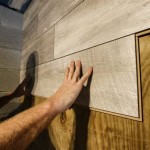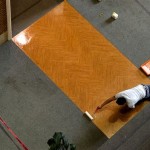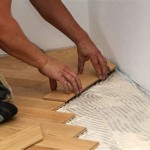Laminate Flooring With Installation Cost: A Comprehensive Guide
Laminate flooring has emerged as a prominent flooring option for homeowners and businesses alike, prized for its durability, aesthetic versatility, and cost-effectiveness. This engineered product replicates the look of natural materials like hardwood, stone, and tile, offering a convincing alternative without the associated price tag or maintenance demands. Understanding the material composition, types, installation process, and associated costs is crucial for making an informed decision when considering laminate flooring for any interior space.
The core of laminate flooring consists of several layers bonded together under high pressure. A wear layer, typically composed of aluminum oxide, provides resistance against scratches, stains, and fading. Beneath the wear layer is a decorative layer, a high-resolution photographic image that replicates the desired aesthetic. An inner core, commonly made of high-density fiberboard (HDF) or medium-density fiberboard (MDF), provides structural stability and impact resistance. Finally, a backing layer provides moisture resistance and helps prevent warping.
The cost of laminate flooring is influenced by various factors, including the quality of the materials used, the thickness of the planks, the specific design and texture, and the brand reputation. Installation costs, however, are a separate consideration and can significantly impact the overall project budget. This article provides a detailed overview of laminate flooring, its different types, the installation process, and a comprehensive breakdown of the factors affecting installation costs.
Key Considerations Before Choosing Laminate Flooring
Prior to selecting laminate flooring, several factors warrant careful consideration. The intended use of the space is paramount. High-traffic areas, such as hallways and living rooms, require a higher abrasion class (AC) rating. The AC rating indicates the flooring's resistance to wear and tear. Laminate flooring is classified from AC1 to AC5, with AC5 offering the highest level of durability.
Moisture resistance is another crucial aspect, particularly for kitchens, bathrooms, and basements. While laminate flooring is generally water-resistant, it is not entirely waterproof. Spills should be cleaned promptly to prevent damage. Some laminate products are specifically designed with enhanced moisture resistance, featuring sealed edges and a waterproof core. Careful attention should also be given to the subfloor which should be level and clean for proper installation.
The overall aesthetic should complement the existing decor and architectural style of the space. Laminate flooring is available in a wide range of styles, colors, and textures, mimicking various wood species, stone types, and tile patterns. It is essential to choose a design that enhances the overall visual appeal of the room. Finally, consider the long-term maintenance requirements. Laminate flooring is relatively easy to maintain. However, understanding the proper cleaning methods and preventative measures will ensure its longevity. Avoid abrasive cleaners or excessive moisture, and use appropriate floor protectors under furniture to prevent scratches.
Types of Laminate Flooring and Their Characteristics
Laminate flooring is available in a diverse range of styles and constructions, each with its unique characteristics and advantages. The most common classifications are based on plank thickness, locking mechanism, and aesthetic appearance.
Based on plank thickness, laminate flooring is generally categorized into 7mm, 8mm, 10mm, and 12mm options. Thicker planks offer enhanced durability, stability, and sound insulation. They also tend to feel more substantial underfoot. Thinner planks are typically more affordable but may be less resistant to impact and wear.
The locking mechanism is another critical factor. Click-lock systems, which use interlocking edges to connect the planks, are the most prevalent type. These systems are relatively easy to install and do not require nails or glue. Glue-down laminate flooring, on the other hand, requires adhesive to secure the planks to the subfloor. While it offers a more permanent bond, glue-down installation is more labor-intensive and may require professional expertise.
In terms of aesthetic appearance, laminate flooring can replicate a wide variety of natural materials. Wood-look laminate is the most popular choice, mimicking various wood species like oak, maple, hickory, and walnut. Stone-look laminate replicates the appearance of natural stone, such as slate, travertine, and marble. Tile-look laminate mimics ceramic or porcelain tiles, offering a cost-effective alternative for kitchens and bathrooms. The surface texture of the laminate flooring can also vary, ranging from smooth to embossed, further enhancing the realism of the replicated material.
Laminate Flooring Installation Process and Considerations
The installation process for laminate flooring involves several key steps, ensuring a proper and long-lasting result. Proper subfloor preparation is crucial. The subfloor should be level, clean, and dry. Any imperfections, such as cracks or unevenness, should be addressed before installation begins. This may involve patching holes, leveling the subfloor with self-leveling compound, or sanding down high spots.
An underlayment is typically installed between the subfloor and the laminate flooring. Underlayment provides cushioning, sound insulation, and moisture resistance. Different types of underlayment are available, including foam, cork, and rubber. The choice of underlayment depends on the specific needs and preferences of the homeowner.
The laminate planks are then installed, following the manufacturer's instructions. Click-lock systems are relatively straightforward to install, requiring minimal tools and expertise. The planks are typically aligned and clicked together, creating a floating floor. Glue-down installation, on the other hand, requires the application of adhesive to the subfloor before placing the planks. This method requires more precision and skill to ensure a proper bond and alignment.
Once the flooring is installed, trim and moldings are added to conceal the edges and create a finished look. This may include baseboards, quarter-round moldings, and transition strips. The trim is typically nailed or glued into place, providing a seamless transition between the flooring and the walls or other flooring surfaces.
Factors Affecting Laminate Flooring Installation Cost
The cost of laminate flooring installation is influenced by several factors, including the size of the installation area, the complexity of the project, the type of laminate flooring, and the labor rates in the specific geographic area. The size of the installation area is a primary factor. Larger areas require more materials and labor, resulting in higher overall costs.
The complexity of the project can also significantly impact the installation cost. Irregularly shaped rooms, intricate patterns, and the presence of obstacles, such as stairs or built-in cabinets, can increase the time and effort required for installation. Subfloor preparation is another critical cost factor. If the subfloor requires extensive repairs or leveling, the cost of materials and labor will increase.
The type of laminate flooring also plays a role in the installation cost. Thicker planks, more intricate designs, and specialized locking mechanisms may require more skill and time to install. Glue-down installation is typically more expensive than click-lock installation due to the added labor and materials involved. Labor rates vary depending on the geographic location and the experience of the installer. Areas with higher costs of living generally have higher labor rates. Obtaining quotes from multiple installers is essential to ensure a competitive price.
Additional costs may include the removal and disposal of existing flooring, the cost of underlayment, trim, and moldings, and any necessary permits or inspections. It is prudent to obtain a detailed estimate from the installer, outlining all the potential costs involved in the project.
Estimating Laminate Flooring Installation Costs
Estimating the cost of laminate flooring installation requires a comprehensive understanding of the various factors involved. The cost of the laminate flooring material itself is typically calculated per square foot. The installation cost is also typically calculated per square foot, based on the labor rate and the complexity of the project. To calculate the total cost, the square footage of the installation area is multiplied by the cost per square foot for both the materials and the installation labor.
For example, if the laminate flooring costs $3 per square foot and the installation cost is $2 per square foot, the total cost per square foot would be $5. For a 200-square-foot room, the estimated total cost would be $1000. This estimate does not include the cost of underlayment, trim, moldings, subfloor preparation, or any additional expenses. Obtaining a detailed quote from a professional installer is essential to get an accurate estimate for the specific project.
Homeowners can also use online cost calculators to get a rough estimate of laminate flooring installation costs. These calculators typically require information about the size of the installation area, the type of laminate flooring, and the geographic location. While these calculators can provide a general idea of the potential costs, they should not be considered a substitute for a professional estimate.
DIY vs. Professional Laminate Flooring Installation
Homeowners can choose to install laminate flooring themselves (DIY) or hire a professional installer. DIY installation can save money on labor costs. However, it requires a certain level of skill, time, and effort. If the homeowner lacks experience with flooring installation, professional installation is recommended to ensure a proper and long-lasting result.
Professional installers have the expertise and tools necessary to handle complex installations, including subfloor preparation, intricate patterns, and challenging room layouts. They can also ensure that the flooring is installed according to the manufacturer's instructions, which is essential for maintaining the warranty. Hiring a licensed and insured contractor provides added protection in case of any issues or damages during the installation process.
DIY installation may be suitable for smaller, simpler projects with minimal subfloor preparation requirements. However, it is essential to carefully consider the potential risks and challenges before attempting a DIY installation. If unsure about any aspect of the installation process, consulting with a professional installer is always recommended.

Cost To Install Laminate Flooring In 2024 Forbes Home

Cost To Install Laminate Floors The Home Depot

2024 Laminate Flooring Installation Cost Guide Angi

How Much Should Laminate Flooring Fitting Cost In 2024 Checkatrade

Understanding Wooden Flooring Cost Per Sq Ft In Lamiwood

Laminate Floor Cost Calculator How Much Does Flooring

How Much Does Laminate Flooring Installation Cost 2024

How Much Does Flooring Installation Cost In 2024 Forbes Home

Laminate Flooring Installation Cost Estimator Estimate Florida Consulting

Wood Flooring Installation Service For Indoor Commercial Building At Rs 75 Sq Ft In Surat
Related Posts








